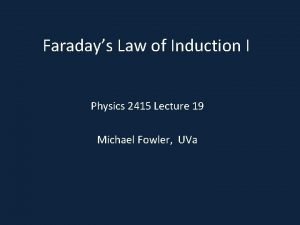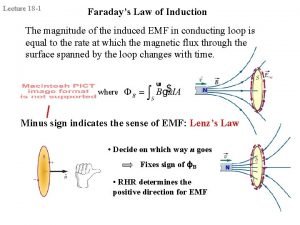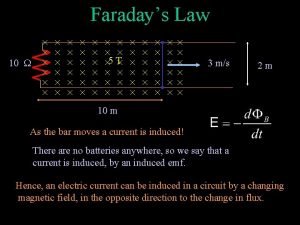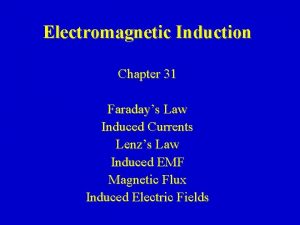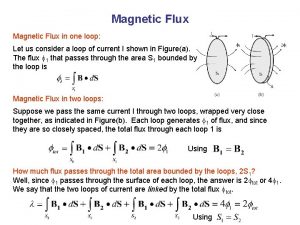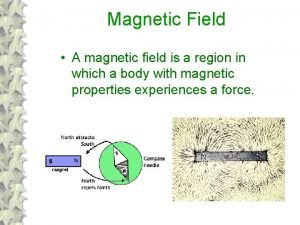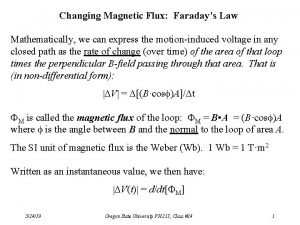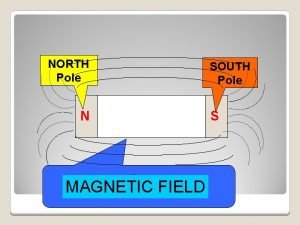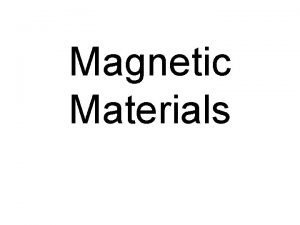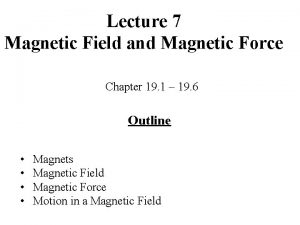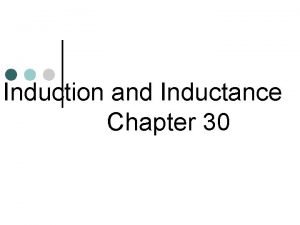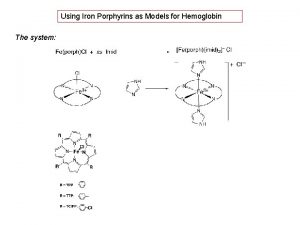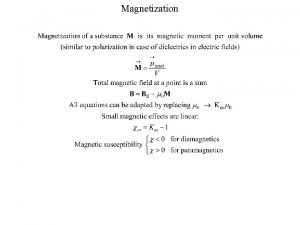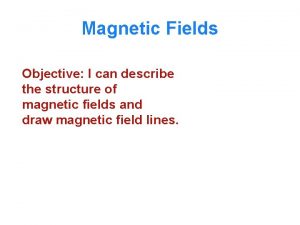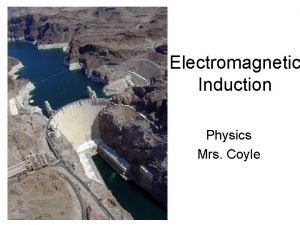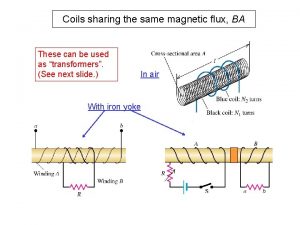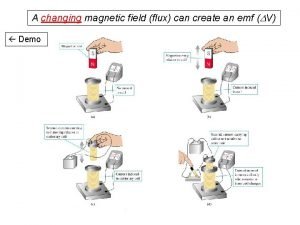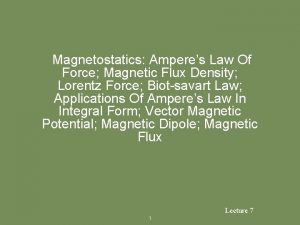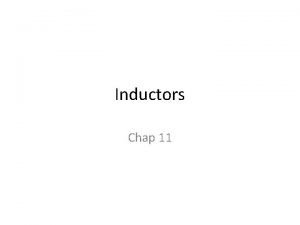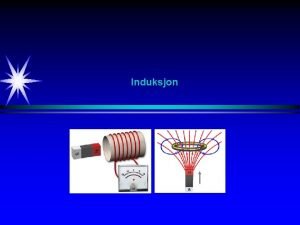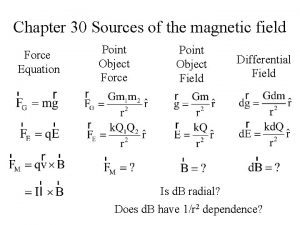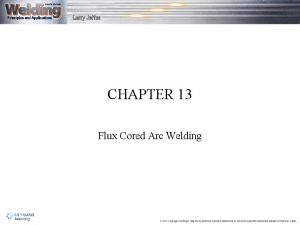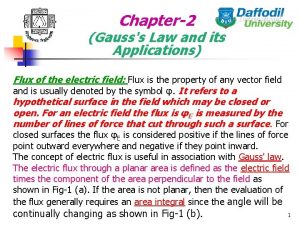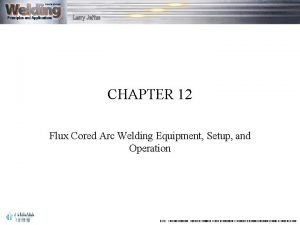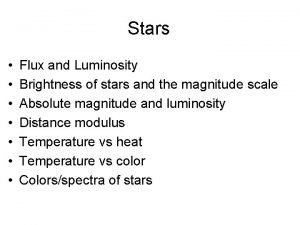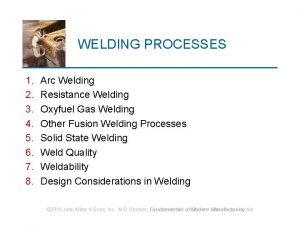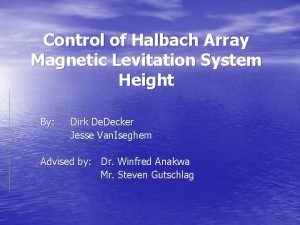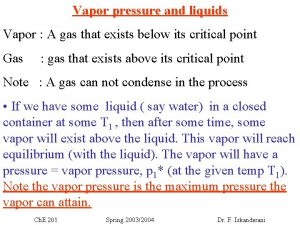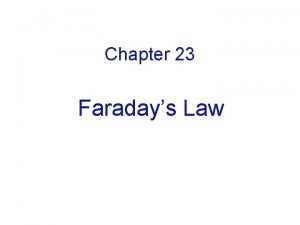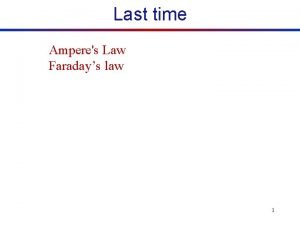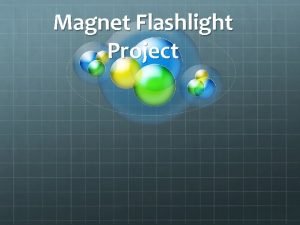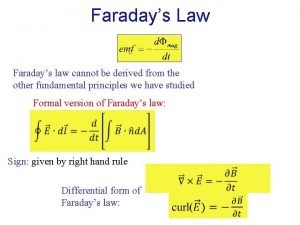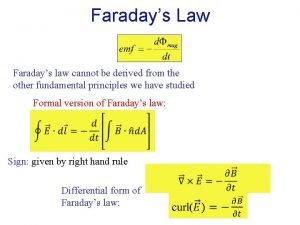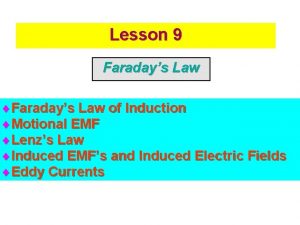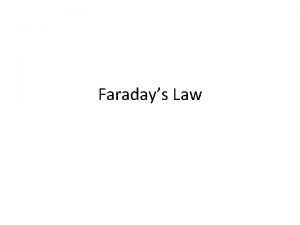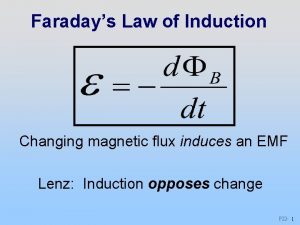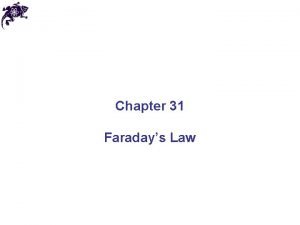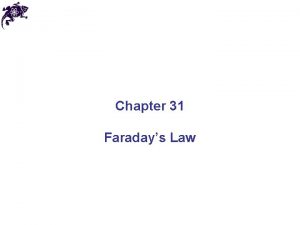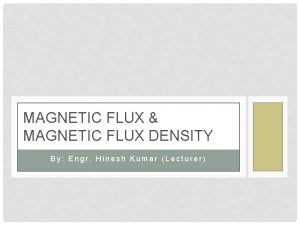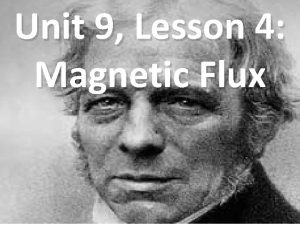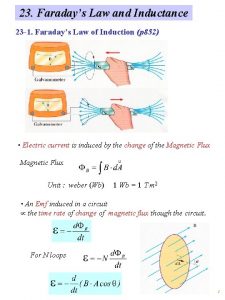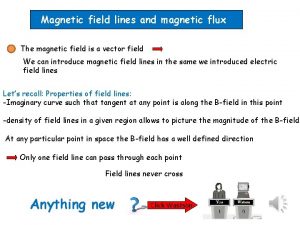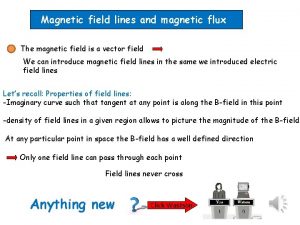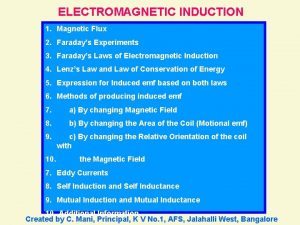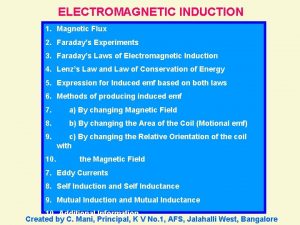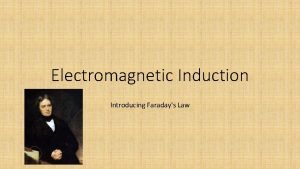Chapter 22 Magnetic Flux and Faradays Law of






































- Slides: 38

Chapter 22 Magnetic Flux and Faraday’s Law of Induction

Chapter 22 • Induced Electromotive Force • Magnetic Flux • Faraday’s Law of Induction • Lenz’s Law • Mechanical Work and Electrical Energy • Generators and Motors • Inductance • RL Circuits • Energy Stored in a Magnetic Field

Electric Currents, Magnetic Fields, and Ampère’s Law-Refresher Experimental observation: Electric currents can create magnetic fields. These fields form circles around the current. Direction of the magnetic field: counterclockwise. Compass needles also show the field’s direction.

Induced Electromotive Force Faraday’s experiment: closing the switch in the primary circuit induces a current in the secondary circuit, but only while the current in the primary circuit is changing.

Induced Electromotive Force Disconnect a battery from a circuit: electric potential difference between the battery’s terminals remains and is called the electromotive force or emf: Another way to describe emf is that it is the voltage generated by any source of electrical energy such as a battery or generator. Both experiments induced a potential difference which makes the current flow. Conclusion: where there is electricity there is magnetism and vice versa.

Induced Electromotive Force • The current in the secondary circuit is zero as long as the current in the primary circuit, and the magnetic field in the iron bar, are not changing. • Current flows in the secondary circuit while the current in the primary circuit is changing. It flows in opposite directions depending on whether the magnetic field is increasing or decreasing. • The magnitude of the induced current is proportional to the rate at which the magnetic field is changing. Conclusion: a changing current in the primary circuit causes a change in the magnetic field which induces a current in the secondary circuit.

Induced Electromotive Force Note the motion of the magnet in each image: Move magnet towards coil Move magnet away from coil

Magnetic Flux Magnetic flux is used in the calculation of the induced emf.

Magnetic Flux

1. A 0. 05 -T magnetic field passes through a circular ring of radius 3. 1 cm at an angle of 16° with the normal. Find the magnitude of the magnetic flux through the ring.

7. A solenoid with 385 turns per meter and a diameter of 17 cm has a magnetic flux through its core of magnitude 1. 28 x 10 -4 T m 2. (a) Find the current in this solenoid (b) What happens if you double the diameter of the solenoid?

Faraday’s Law of Induction Faraday’s law: An emf is induced only when the magnetic flux through a loop changes with time.

Lenz’s Law: An induced current always flows in a direction that opposes the change that caused it. More specifically: An induced current always flows in a direction that creates a magnetic field that opposes the change that caused it. The change is in the magnetic field that caused the current. Changing motion of the magnet changes the magnetic flux which induces the current. The current flows in the opposite direction of the magnet.

Lenz’s Law-Summary We know: • Flow of electricity (i. e. current) induces a magnetic field • Change in magnetic flux (i. e. moving/changing magnetic field) induces a current • Change in direction of magnet changes flux and creates current. The current creates a magnetic field whose direction is opposite that of the magnetic field produced by the magnet. Lenz’s Law: An induced current always flows in a direction that opposes the change that caused it.

Back to the Negative Sign in Lenz’s Law Magnet & ring move closer: final flux is greater than initial; Magnet and ring move away from each other final flux is smaller than initial, current is opposite direction creating attractive force and that is opposite the direction of the magnetic (moving away from ring) Lenz’s and Faraday’s Laws hold regardless of what causes the change in magnetic flux.

Application: Transcranial Magnetic Stimulation

9. A 0. 45 -T magnetic field is perpendicular to a circular loop of wire with 53 turns and a radius of 15 cm. If the magnetic field is reduced to zero in 0. 12 s, what is the magnitude of the induced emf?

10. Figure 23 -26 shows the magnetic flux through a coil as a function of time. At what times shown in this plot do (a) the magnetic flux and (b) the induced emf have the greatest magnitude?

Lenz’s Law This conducting rod completes the circuit. As it falls, the magnetic flux decreases, and a current is induced. The current flows right to left in the rod (counterclockwise through circuit which opposes the motion of the rod).

Lenz’s Law The force due to the induced current is upward, slowing the fall.

Lenz’s Law We’ve looked at wires in magnetic fields - the wires contain the current and carry the current in organized path. Put a non-wire conductor in a changing magnetic field - electric current is still generated by swirls around Motion through a magnetic field produces a motional emf

Application of Eddy Currents Trains, roller coasters, exercise bikes.

Mechanical Work and Electrical Energy Magnetic flux between bulb and rod: Φ=BA Move rod: Eq 2 -2: average speed=distance/elapsed time ΔA = (vΔt)l where l=lengthchange of rod in flux

Mechanical Work and Electrical Energy Change in flux: Induced emf: Difference in electric potential (voltage) caused be E over a length l is V =El Electric field caused by the motion of the rod:

Mechanical Work and Electrical Energy If the rod is to move at a constant speed, an external force must be exerted on it. This force should be equal in magnitude and opposite in direction to the magnetic force:

Mechanical Work and Electrical Energy The mechanical power delivered by the external force is: Compare this to the electrical power in the light bulb: Conclusion: Changing magnetic flux converts mechanical energy to electrical energy. Also, mechanical power has been converted directly into electrical power.

Generators and Motors An electric generator converts mechanical energy into electric energy. An outside source (mechanical input) of energy is used to turn the coil, thereby generating electricity. Replace linear motion of rod with a coil of wire that is rotated to produce magnetic flux which induces current.

Inductance Using one circuit to induce a current in another is known as mutual inductance.

Inductance When the switch is closed in this circuit, a current is established that increases with time and produces a magnetic flux that increases with time. Effect is an induced emf in the coil that opposes increases (& decreases) in current. The coil (inductor) resists changes in the flow of current and stores energy.

Inductance is the proportionality constant that tells us how much emf will be induced for a given rate of change in current: Solving for L,

RL Circuits When the switch is closed, the current immediately starts to increase. The emf in the inductor is large, as the current is changing rapidly. As time goes on, the current increases more slowly to its final value, and the potential difference across the inductor decreases.

Energy Stored in a Magnetic Field It takes energy to establish a current in an inductor; this energy is stored in the inductor’s magnetic field. Considering the emf needed to establish a particular current, and the power involved, we find:

Energy Stored in a Magnetic Field The volume inside the solenoid is where the magnetic field is located. Magnetic energy per unit volume is This result is valid for any magnetic field, not just for solenoids.

Transformers A transformer is used to change voltage in an alternating current from one value to another. Step up transformers boost a power plant’s output voltage from 12000 V to 240, 000 volts which is carried through the transmission lines to the destination. Step down transformers are located near the destination to reduce the voltage to the required voltage for the destination (i. e. 240 V for homes).

Summary of Chapter 22 • A changing magnetic field can induce a current in a circuit. The magnitude of the induced current depends on the rate of change of the magnetic field. • Magnetic flux: • Faraday’s law gives the induced emf:

Summary of Chapter 22 • Lenz’s law: an induced current flows in the direction that opposes the change that created the current. • Motional emf: • emf produced by a generator: • An electric motor is basically a generator operated in reverse. • Inductance occurs when a coil with a changing current induces an emf in itself.

Summary of Chapter 22 • Definition of inductance: • Inductance of a solenoid: • An RL circuit has a characteristic time constant:

Summary of Chapter 22 • Current in an RL circuit after closing the switch: • Magnetic energy density: • Transformer equation:
 Magnetic permeability of materials
Magnetic permeability of materials Magnetic flux density and magnetic field
Magnetic flux density and magnetic field Paramagnetic
Paramagnetic Faraday law of electromagnetic induction
Faraday law of electromagnetic induction Faradays law
Faradays law Faraday law of electromagnetic induction
Faraday law of electromagnetic induction Magnetic flux and inductance
Magnetic flux and inductance Radial magnetic field
Radial magnetic field Express magnetic flux mathematically
Express magnetic flux mathematically Characteristics of a magnetic field
Characteristics of a magnetic field Magnetic quantities
Magnetic quantities Si unit of magnetic force
Si unit of magnetic force Magnetic flux formula
Magnetic flux formula Flux magnetic
Flux magnetic Magnetization formula
Magnetization formula F=bqvsinθ
F=bqvsinθ Magnetic flux
Magnetic flux Flux=ba
Flux=ba Flux magnetic
Flux magnetic Magnetic flux density vector
Magnetic flux density vector Magnetic flux density equation
Magnetic flux density equation Faraday's constant
Faraday's constant Faradays induksjonslov
Faradays induksjonslov Magnetic moment and magnetic field relation
Magnetic moment and magnetic field relation Force on a charged particle
Force on a charged particle Newton's first law and second law and third law
Newton's first law and second law and third law Newton's first law and second law and third law
Newton's first law and second law and third law V=k/p
V=k/p Avogadro's law constant
Avogadro's law constant Magnetic field due to a curved wire segment
Magnetic field due to a curved wire segment Chapter 13 smaw horizontal position
Chapter 13 smaw horizontal position Flux chapter 2
Flux chapter 2 Fcaw vs gmaw
Fcaw vs gmaw Absolute magnitude to luminosity
Absolute magnitude to luminosity Resistance arc welding
Resistance arc welding Halbach array flux diagrams and calculations
Halbach array flux diagrams and calculations Conceptual physics magnetism
Conceptual physics magnetism Raoult's law and dalton's law
Raoult's law and dalton's law Difference between civil law and criminal law
Difference between civil law and criminal law


